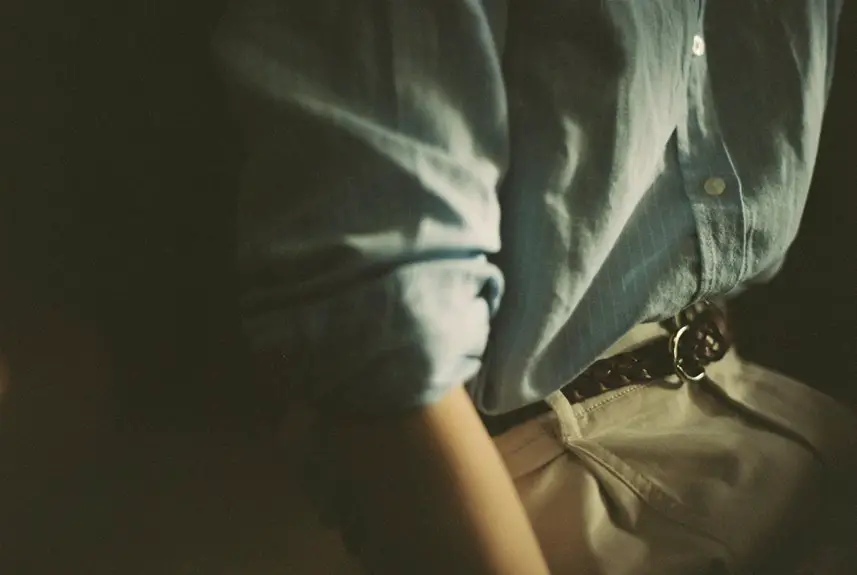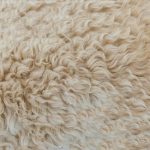You might hear “chino” referring to both a fabric and a style, but they’re not the same. Chino fabric is a durable, lightweight cotton twill originally made for military uniforms, known for its smooth texture and breathability. Chino style means clean-cut, tailored clothing—like pants or jackets—with a polished yet casual look. Understanding this helps you pick the right pieces and wear them well. Keep exploring, and you’ll discover more about fits, colors, and styling tips.
Table of Contents
Key Takeaways
- Chino fabric is a durable, lightweight cotton twill originally used for military uniforms due to its strength and comfort in warm climates.
- The chino style refers to clothing made from this fabric, characterized by tailored fit, clean lines, and smooth texture.
- Chino pants differ from jeans and dress trousers by combining comfort with a polished, wrinkle-resistant appearance and breathable cotton material.
- Popular chino colors include khaki, navy, olive, grey, and burgundy, offering versatility from casual to semi-formal wear.
- Proper care involves washing chinos inside out in cold water, avoiding bleach, and ironing damp for a neat, crisp finish.
The History of Chino Fabric
Although chino fabric is widely associated with casual and semi-formal clothing today, it originally served a very practical purpose.
Back in the 19th century, the fabric was designed for military uniforms, especially for British and later American soldiers stationed in warm climates. You’ll find that its tightly woven cotton twill made it durable and comfortable, perfect for the rigors of military use.
Originally crafted for 19th-century British and American military uniforms in warm climates due to its durable cotton twill.
When the soldiers returned home, they kept wearing their sturdy trousers, and civilians quickly adopted the style.
Over time, chino evolved from purely functional military wear to versatile everyday apparel.
Characteristics of Chino Fabric
You’ll notice chino fabric features a cotton twill weave that makes it both durable and lightweight.
It feels smooth to the touch, giving it a clean, polished look.
Understanding these qualities helps you appreciate why chinos are so popular in everyday wear.
Cotton Twill Weave
The hallmark of chino fabric lies in its cotton twill weave, which gives it durability and a subtle diagonal pattern. When you look closely, you’ll notice the distinct diagonal ribs running across the fabric, a result of the twill weaving technique.
This weave not only strengthens the fabric but also enhances its texture, making it feel smooth yet sturdy. Because of this structure, chino fabric resists wrinkles better than plain weaves, keeping your pants looking sharp throughout the day.
You’ll also find that the twill weave allows for better breathability, helping you stay comfortable. Understanding this weave helps you appreciate why chinos strike a balance between casual and polished, perfect for versatile wear.
Durable and Lightweight
Because chino fabric combines strength with a lightweight feel, it offers durability without weighing you down.
When you wear chinos, you get a fabric that can handle daily wear and tear, making it perfect for both casual and semi-formal occasions. The cotton twill weave reinforces the fabric’s resilience, so it resists rips and abrasions better than many other materials.
You’ll notice that chinos stay comfortable all day because their lightweight nature allows breathability and ease of movement. This balance means you don’t have to sacrifice comfort for toughness.
Whether you’re moving through a busy day or relaxing after work, chino fabric keeps up with your pace, making it a reliable choice for versatile, long-lasting wear.
Smooth Finish Texture
Chino fabric doesn’t just offer durability and comfort—it also stands out with its smooth finish texture. When you run your fingers over chino, you’ll notice a sleek surface that feels soft but not slippery.
This smoothness comes from the twill weave and finely spun cotton fibers, which create a tight, even fabric. Unlike rougher materials, chino’s texture gives it a polished look, making it versatile enough for both casual wear and more formal settings.
You’ll appreciate how this smooth finish resists wrinkles and maintains a crisp appearance throughout the day. So, if you want fabric that feels good and looks sharp without extra effort, chino’s smooth texture is a major advantage you’ll definitely want in your wardrobe.
How Chino Fabric Is Made
When you look closely at how this fabric is made, you’ll see a careful process that combines durability with comfort.
Chino fabric starts with high-quality cotton, spun into a tight, smooth yarn. The yarn undergoes a twill weave, creating diagonal lines that give chino its signature strength and subtle texture. This weaving technique also enhances the fabric’s durability, making it perfect for everyday wear.
Chino fabric’s twill weave creates durable, textured cotton perfect for everyday comfort and strength.
After weaving, the fabric is dyed, often with earth tones like khaki or olive, adding to its classic appeal. Finally, the fabric receives a finishing treatment that softens its feel while maintaining its structure.
This meticulous process guarantees that chino fabric remains both sturdy and comfortable, ready to be tailored into versatile garments you’ll want to wear often.
Defining Chino Style in Clothing
You’ll recognize chino style by its clean lines, tailored fit, and smooth cotton twill fabric.
Chino pants are the most common garment, but you’ll also find chinos in shorts and jackets.
Their versatility makes them a popular choice for both casual and smart-casual looks.
Key Style Characteristics
Although often mistaken for just a type of fabric, chino style is defined by its clean lines, tailored fit, and versatile look.
When you wear chinos, you notice the smooth, flat front without pleats, creating a streamlined silhouette that fits comfortably without being too tight or loose. The casual yet polished aesthetic comes from subtle details like slanted side pockets and welted back pockets, which keep the design simple and refined.
You’ll also find that chinos typically have a mid-rise waist, striking a balance between formal and casual wear. The fabric’s slight sheen adds to their neat appearance, making chinos adaptable for various occasions.
Understanding these key characteristics helps you distinguish chino style beyond just the material used.
Common Garment Types
Since chino style extends beyond fabric, it’s important to recognize the common garment types that embody this look.
You’ll often find chinos in the form of trousers, characterized by their tailored fit, straight or slightly tapered legs, and minimal detailing. These pants typically feature slanted front pockets and welted or buttoned back pockets, emphasizing clean lines.
Beyond pants, chino-style shirts and jackets also capture this aesthetic, offering a structured yet casual vibe. When you wear chino pants, pairing them with a crisp button-down or a lightweight blazer can complete the look.
Popularity and Usage
Chino style has become a wardrobe staple for many, blending comfort with a polished look that works in various settings. Whether you’re dressing up for a casual office day or heading out for a weekend brunch, chinos offer versatility that few other garments match. You’ll find chinos embraced across age groups and fashion preferences because they effortlessly balance formal and casual vibes.
Here’s a quick look at chino popularity and usage:
| Setting | Occasion Type | Style Tip |
|---|---|---|
| Workplace | Business Casual | Pair with a button-up shirt |
| Casual Outings | Everyday Wear | Match with a simple tee |
| Social Events | Smart Casual | Combine with a blazer |
With chinos, you can always adjust your look to fit the occasion seamlessly.
Differences Between Chino Pants and Other Trousers
When you compare chino pants to other trousers, you’ll notice they blend casual comfort with a sharper look. Unlike denim jeans, chinos use a lighter, twill-woven cotton fabric that feels softer and looks cleaner.
They’re less rugged than cargo pants, lacking extra pockets or bulky details, making them more versatile for both casual and semi-formal occasions. Compared to dress trousers, chinos don’t have heavy linings or creases but still maintain a tailored fit that elevates your style without sacrificing ease.
You’ll also find chinos more breathable and flexible than traditional wool or synthetic trousers, making them great for warmer weather. Overall, chinos strike a balance—offering a polished appearance while keeping comfort front and center, setting them apart from other pant options.
Popular Colors and Fits in Chino Style
Understanding how chinos differ from other trousers helps you appreciate why their colors and fits matter in crafting your look.
Knowing what sets chinos apart highlights the importance of choosing the right colors and fits for your style.
When choosing chinos, you want colors that seamlessly blend with your wardrobe and fits that enhance your silhouette. Popular colors offer versatility and style, while fit influences comfort and confidence.
Here are some favorites that resonate with many:
- Classic khaki, for timeless appeal
- Navy blue, adding depth and sophistication
- Olive green, bringing subtle earthiness
- Light grey, perfect for a modern vibe
- Burgundy, for a bold, stylish statement
Fits range from slim to relaxed, letting you pick what suits your shape and occasion.
Choosing the right color and fit makes your chinos a reliable staple in your closet.
Styling Tips for Chino Clothing
Although chinos offer great versatility, styling them effectively can elevate your entire outfit.
Start by pairing slim-fit chinos with a crisp button-down shirt for a polished, casual look. You can roll the cuffs slightly to add a relaxed vibe.
For a more laid-back style, match your chinos with a well-fitted t-shirt or polo. Don’t hesitate to mix colors—navy chinos look sharp with white or light blue tops, while khaki pairs well with earth tones.
Footwear matters too; loafers or clean sneakers keep it smart-casual, while boots add rugged appeal.
Finally, layering with a lightweight jacket or blazer can enhance your ensemble without overshadowing the chinos. Keep your accessories minimal to let the chinos stand out.
How to Care for Chino Fabric and Garments
Taking proper care of your chinos guarantees they stay sharp and last longer. You want to maintain their fit, color, and softness, so follow these simple steps:
- Wash chinos inside out in cold water to preserve color.
- Use a gentle cycle and mild detergent to avoid fabric damage.
- Avoid bleach or harsh chemicals that weaken fibers.
- Hang dry or lay flat instead of using a dryer to prevent shrinking.
- Iron on a medium setting while chinos are slightly damp for crispness.
Frequently Asked Questions
Can Chino Fabric Be Used for Jackets or Only Pants?
You can definitely use chino fabric for jackets, not just pants. Its durability and smooth texture make it perfect for lightweight jackets, offering a casual yet polished look you’ll appreciate in various settings and seasons.
Are Chinos Suitable for Formal Office Wear?
You can definitely wear chinos to the office, especially if your workplace has a business casual dress code. They look sharp, pair well with blazers, and keep you comfortable all day without feeling too formal.
How Do Chinos Compare in Breathability to Denim?
You’ll find chinos more breathable than denim because they’re made from lighter cotton twill fabric. Denim’s heavier weave traps heat, while chinos let air flow better, keeping you cooler and more comfortable in warmer weather.
Can Chinos Be Machine Washed With Colored Clothes?
It’s convenient that you can machine wash chinos with colored clothes, but you should check the care label first. Since some chinos may bleed color, washing them separately the first few times helps prevent any mishaps.
Do Chino Fabrics Shrink After the First Wash?
Yes, chino fabrics can shrink slightly after the first wash, especially if you use hot water or high heat drying. To avoid shrinkage, wash them in cold water and air dry or tumble dry low.
- Where to Buy Fabric in China: Top Sources and Markets - June 20, 2025
- The Most Highly Prized Fabric in Ancient China - June 20, 2025
- What Type of Fabric Is Chino? Understanding Chino Material - June 20, 2025







